Trigger Point Therapy for Myofascial Pain (11 page)
Read Trigger Point Therapy for Myofascial Pain Online
Authors: L.M.T. L.Ac. Donna Finando

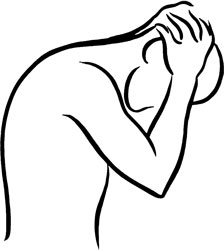
Stretch exercise: Posterior cervicals
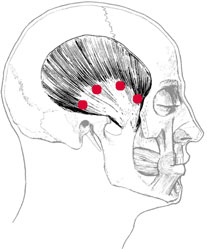
Temporalis and trigger points

Temporalis pain pattern
T
EMPORALIS
Proximal attachment:
Lateral skull in front of and above the ear in the temporal fossa.
Distal attachment:
Coronoid process of the mandible.
Action:
Elevation of the mandible, closing the jaw; posterior fibers act in retraction of the mandible.
Acting unilaterally:
deviation of the mandible to the same side.
Palpation
: To locate the temporalis, spread the fingers across the muscle just posterior to the temples and above the ears. Gentle compression of the rear teeth will produce contraction of the muscle, which will be easily experienced under the palpating hand
Palpate temporalis moving caudal to its attachment at the coronoid process of the mandible. With the mouth relaxed and open, identify trigger points in various portions of the belly of the muscle using a cross-fiber palpating technique. Trigger points that occur at the junction of the muscle fibers and its distal attachment may be found approximately 1 inch above the zygomatic arch.
Pain pattern:
Temporal headache and maxillary toothache. Pain extends over the temporal region to the eyebrow, the upper teeth, and occasionally to the maxilla and the temporomandibular joint (TMJ). Trigger points can refer pain, tenderness, and hypersensitivity of the upper teeth to hot, cold, and pressure. Patients rarely complain of restricted jaw movement.
Causative or perpetuating factors:
Excessive forward head posture; overuse of the muscle due to gum chewing, jaw clenching, or bruxism; chronic overuse due to an anteriorly displaced temporomandibular joint disc; direct trauma to the muscle caused from a fall or impact to the side of the head; secondary to trigger points in the sternocleidomastoid or upper trapezius.
Satellite trigger points:
Contralateral temporalis, ipsilateral masseter, trapezius, sternocleidomastoid.
Affected organ system:
Digestive system.
Associated zones, meridians, and points:
Lateral zone; Foot Shao Yang Gall Bladder meridian; GB 3â7.
Stretch exercise:
Spread the fingers across the muscle, just posterior to the temples and above the ears. Open the mouth as wide as possible and inhale. On the exhale, press upward along the fibers of the muscle.
Strengthening exercise
: Due to the nature of this muscle, strengthening exercises are not necessary.

Stretch exercise: Temporalis
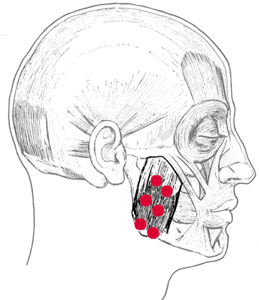
Masseter and trigger points

Masseter pain pattern
M
ASSETER
Proximal attachment:
Superficial layer:
anterior two-thirds of the zygomatic arch.
Deep layer:
posterior one-third of the zygomatic arch.
Distal attachment:
Superficial layer:
external surface of the mandible at its angle and the inferior half of the ramus of the mandible.
Deep layer:
lateral surface of the coronoid process of the mandible and the superior half of the ramus.
Action:
Elevation of the mandible, closing the jaws.
Palpation:
Palpate masseter with teeth slightly separated and the jaw relaxed. Beginning just below the zygomatic arch, palpate muscle fibers distally toward the angle of the mandible. Gently compressing the teeth will aid in the identification of masseter; however, the presence of the parotid gland may hinder clear identification of muscle fibers. Palpate on the inside of the cheek with a gloved hand. Place one finger within the mouth and another on the outside of the cheek to support the palpating thumb. Using cross-fiber palpation, locate taut bands of masseter.
Pain pattern:
Superficial layer:
Pain at the upper teeth and cheek, sometimes identified as sinus pain; pain at the lower teeth and jaw, above the eyebrow, and at the region of the temporomandibular joint (TMJ).
Deep layer:
Pain in the cheek and TMJ area deep in the ear; patient may experience unilateral tinnitus that is not associated with loss of hearing or vertigo and/or a marked restriction of mouth opening. Unilateral trigger points produce restricted mouth opening with deviation to the ipsilateral side. Symptoms include sensitivity to pressure, heat, and cold; restricted jaw opening. (Normal jaw opening will allow the comfortable insertion of the knuckles of two stacked fingers into the mouth.)
Causative or perpetuating factors:
Forward head posture; chronic mouth breathing; acute overload from forcible contraction of the masseter as might occur while biting something quite hard; bruxism, clenching, gum chewing, nail biting; occlusion difficulties that might be resultant from the loss of natural teeth or illfitting dentures; psychological stresses; overstretching that might occur with dental work; trauma from a blow to the head; chronic infection; as a satellite trigger point to sternocleidomastoid or upper trapezius.
Satellite trigger points:
Temporalis, medial pterygoid, contralateral masseter.
Affected organ system:
Digestive system.
Associated zones, meridians, and points
: Lateral zone; Foot Yang Ming Stomach meridian; ST 5 and 6.
Stretch exercise
: Ask the patient to slowly open the mouth against mild resistance placed on the lower jaw. Hold against light resistance for a count of three to five. Repeat three times. Following this stretch cycle, open and close the mouth several times without resistance. Note: This may be used as a trigger point release technique as well as a stretch exercise for the patient.
Strengthening exercise
: Due to the nature of this muscle, strengthening exercises are not necessary.
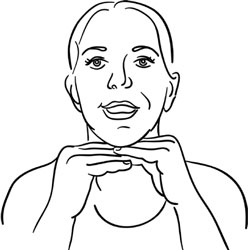
Stretch exercise: Masseter
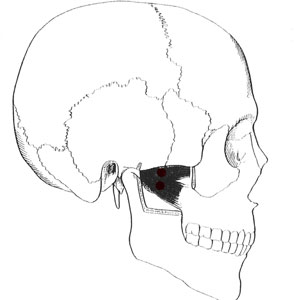
Lateral pterygoid and trigger points
P
TERYGOIDS
M
EDIAL
(
INTERNAL
) P
TERYGOID AND
L
ATERAL
(
EXTERNAL
) P
TERYGOID
Proximal attachment:
Medial pterygoid:
medial surface of the lateral pterygoid plate of the sphenoid bone; the maxillary tubercle.
Lateral pterygoid:
lateral surface of the lateral pterygoid plate of the sphenoid bone; the greater wing of the sphenoid at the base of the skull.
